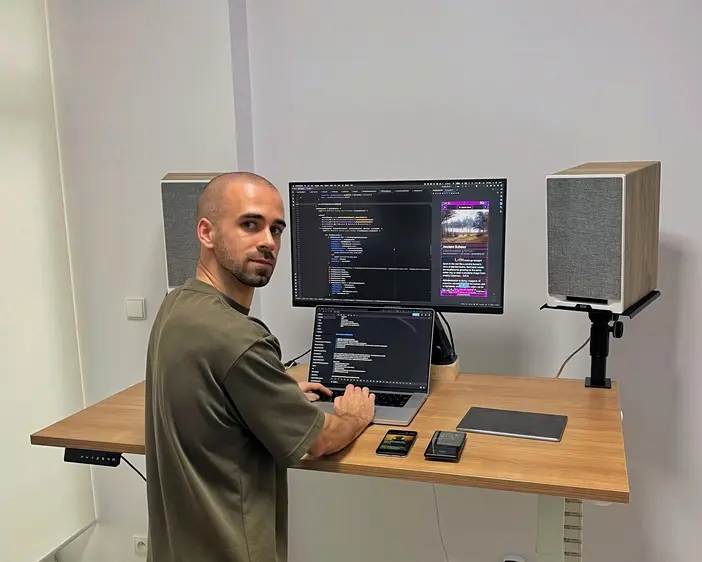I dream to read more and built the best reading app out there
Hey, this is Stan, the founder of Quickify.
I started this project back in the lockdown times, when I accidentally sat on my Kindle and cracked its screen.
I enjoyed reading on my Kindle focusing more on articles from platforms like Hacker News and stuff from my favorite authors and sometime going through whole books.
Even with all the cool stuff popping up on my algorithm-powered social media feeds, I still find a thrill in diving into interesting articles during my free time.
Crushed screen turned into a startup idea!
Trying to find an app for my phone that could replace Kindle, I was surprised to discover that no app in the Google Play Store could fully satisfy my needs. After using over 20 applications, I realized that while each had certain features I appreciated, none encompassed all of them.
Recognizing the potential as an Android Developer, I seized the opportunity to create the app myself. On September 12, 2020, I initiated my first commit into what I later called Quickify.

What sort of reading thing do I need?
First of all, I was looking for an app that could combine all my reading habits in one place: books, articles, RSS feeds and other sources. I didn't see a reason why I should use one app for reading books and then switch to a browser for articles.
Secondly, since I read more articles from the internet, I frequently encountered challenges with the diverse nature of websites and their individual designs. Some sites might feature a small font or lack a mobile-friendly version, requiring me to zoom in on the page. On the other hand, certain websites might not offer a dark theme, transforming night reading into a less than ideal experience:

Thirdly, I sought a way to read online articles without the typical interruptions such as persistent cookie pop-ups, requests to subscribe to newsletters, and other bothersome elements commonly found on websites.
And finally, and perhaps most importantly, my biggest request was for some improvement in the usual reading process. I knew that there are many alternative reading and speed reading methods, and I believed that by incorporating them into my app, I could solve many of these problems and increase reading efficiency.
Advanced and Speed reading
Rapid Serial Visual Presentation, also known as RSVP and Spritz, is the first method that formed the basis of Quickify, and perhaps even gave it its name.
I was very surprised when I easily read a couple of articles for the first time at a speed of 500 words per minute, when average reading speed is about 220 WPM. Of course, it wasn't always a very thoughtful reading, but nevertheless, it's quite impressive how a simple program can so significantly modify the usual reading experience. Then I began to search for other unusual reading methods, compiled a set of five, and implemented them in Quickify.
Each of these methods, in addition to the traditional reading experience found in other applications, helps increase reading speed and convenience, allowing you to read more and enjoy it.
- Text-to-speech is the most popular reading method among Quickify users. I'm using it when I'm busy or my eyes need a rest. This method is available in many other applications, but trust me, I've optimized it to be the best among them all.
- Speed-Reading, also known as RSVP or Spritz. This method is based on the fact that the speed of reading is limited by the speed of eye movement. By displaying one word at a time, you can read almost twice as fast with almost no training.
- The Cursor reading method, with its moving cursor that highlights text at a preferred speed, is designed for enhanced focus and faster reading. It guides through the text, reducing distractions and the likelihood of skipping or re-reading lines.
- The Bionic reading method emphasizes the initial parts of words to speed up reading and comprehension by helping the brain quickly process text with less cognitive effort.
Web reading and highlighting
The trickiest part of building the app was getting rid of all the junk on web pages and making them look good in the app. I borrowed some ideas from how Mozilla Firefox does it and then spent a bunch of time tweaking things to make it just right for my app.
I had two things to do: tidy up web pages by borrowing some codes from Mozilla, and then show all the web stuff in the app—links, pics, videos, gifs, fancy formatting, and tables. I really focused on it, and now Quickify makes all these things look damn beautiful.
From eBooks to articles to RSS
Quickify isn't just for eBooks and articles — it really comes alive with RSS. Unlike Kindle, it's not just about books; Quickify brings in all sorts of content from different sources, thanks to the lively and up-to-date nature of RSS feeds.
Offline
Whenever I read articles online, it bugs me that they might vanish or the web server goes down, especially when I want to revisit old reads. Quickify solves this annoyance by storing all added links locally. So, with Quickify, I know I can enjoy any article from start to finish, internet or no internet.
What's next?
Quickify already possesses all the features necessary to become your primary tool and assistant for reading. I have invested a tremendous amount of effort into this app, and its performance is so impressive that it has become one of my main applications on my phone, despite the fact that I am its developer. You can check out my near-term development plans for the app here.
You are welcome to join the Quickify Community and share your thoughts and ideas on how to make Quickify even better.